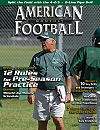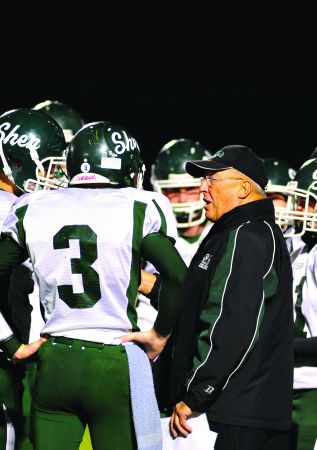Article CategoriesAFM Magazine
|
Steuerwald’s Rules – A coaching legend shares his guidelines for designing and implementing an effective pre-season practice schedule.by: Steve Dorsey© More from this issue In sixty days or less, your 2011 team will be assembled for pre-season practice. They’ll be pushing themselves to achieve peak physical condition, battling each other for higher spots on the depth chart and, in most places around the country, struggling to get through practices in oppressive heat and humidity.
While there may be no single blueprint for designing a perfect practice schedule, there are certain guidelines that, according to Brent Steuerwald of Shenendehowa High School in Clifton Park, New York, every coach should consider when planning practice sessions in the weeks prior to the first game. During his 54 years of coaching, including the past 43 as the head coach at Shenendehowa, Steuerwald has adjusted to numerous changes in the game. His career coaching record of 307-88-4 is proof that he’s adapted quite well. “There’s always something new,” Steuerwald said. “You have to adapt. That’s the fun thing, because it’s a challenge.” One thing in his approach to coaching that has not changed over the years, however, is his belief that the first three weeks of fall practices leading up to the season opener are the most important weeks of the season. “They are critical,” Steuerwald said. “You can’t go undefeated if you don’t win the first game.” Coach Steuerwald, who turns 76 this month, points out that almost half of his team’s practices each season are conducted during the three weeks prior to the first game. Like many coaches, he has two-a-day practices Monday through Friday before fall classes begin, and also holds a single practice on Saturday morning. That’s 11 practice sessions each of the first two weeks and four more the week of the season opener. That’s why so much work goes into planning every session, every drill, basically every minute of three weeks worth of practices. “Prior Planning Prevents Pitiful Poor Performance” is Steuerwald’s motto and it is evident when you look at the daily practice organizational charts, which he is generously sharing with AFM readers. (Note: Detailed charts for all 22 practice sessions can be downloaded and printed by clicking here) He believes that time is one of the most important things in our lives and “one of the few things we all have equally as coaches.” It’s something that can never be recaptured. “Coaching football is a critical race against time,” he said, “and it’s essential to constantly prioritize and build a sense of urgency into every plan and practice session.” “Early season is the most threatening time for heat-related concerns,” he said. Water breaks are frequent and players are instructed to remove their helmets and pull up their shirts/jerseys during instructional talks with the coaches. Steuerwald encourages players to bring their own gallon jugs of water and/or Gatorade that are labeled with their names so that they’ll always be able to hydrate quickly during breaks. “I really dislike the concept of cutting,” he said. Steuerwald never posts a list of those players who did not make the team. Instead, he meets with each one individually. “I ask each one if they think they’ve been given a fair chance to make the team. And 99 percent say, ‘Yes.’ But if one says, ‘No,’ I’ll give them a chance after the Saturday scrimmage and tell them they can come back Monday and Tuesday, but they’re going to go up against the best to prove they deserve a spot on the team.” Steuerwald generally has a varsity roster of between 38-42 players, and no more than 45. His typical roster will include 15 players who are two-way players but their main priority will be on either offense or defense. There’s another 15 players who he calls his prep squad for the opponent on a particular week, but they have a chance to move up on the depth chart if they prove themselves on the prep squad. “I’d rather face the issues (regarding playing time) in August instead of later,” he said. To help his coaching staff focus on key principals of effective planning, Steuerwald developed a list of 12 guidelines that define his practice organization philosophy. At the end of the chart listing the guidelines, Steuerwald delivers a message to his assistants. “BELIEVE IN OUR PLAN – NOTHING GOOD HAPPENS BY ACCIDENT.” It’s an appropriate way to sum up the 54-year coaching veteran’s core belief in planning and attention to every detail as the keys to successful practices and success on the playing field. “Explain why you want every drill done the way you’re teaching it. You have to move quickly from teaching to training and reps are important. There’s no idle time. Time is precious. Listen carefully and understand each part of the drill. It’s very important to teach correctly, and then get into training drills,” he said. “Repetition is important. You can never have too many reps.” That doesn’t mean that Steuerwald and his staff won’t adapt their drill progressions to reflect the skills of his players. “Fundamentals and skills that we emphasize during the early part of the season are dependent on the returning players’ level of skill matched up with our junior varsity players moving up,” Steuerwald said. “Our drills are consistent regardless, but tempo of installation and repetition is subject to daily evaluation and discussion.” “We spend a lot of time evaluating players and our opponents,” he says. “If we’re having a problem with team pursuit, for instance, then we have to practice extra on that aspect or perhaps address a personnel change. Again, you have to adapt and adjust as the situation demands. I don’t think in all the years I’ve coached that I’ve used exactly the same practice plan, although the first two weeks (in August) are probably the most consistent.” He values the opinions of his assistant coaches and encourages them to speak up if they believe something needs to be changed or tweaked that would benefit the team. “I enjoy a little bit of dissent and argument,” he said. “I think it’s good for my coaches to think things through.” “I’ll adapt the practice plan based on evaluation of each practice. If we have a problem with backs blocking ends, then I’ll tell my assistants that we need to work harder on that.” Again, feedback from assistants is critical. “The tempo of new phases is dependent on how coaches evaluate achievement level,” Steuerwald said. “An athlete needs to think and do. It’s the power of positive imagery. Ask a player to think his way through each play,” Steuerwald said. “For instance, tell your quarterback to visualize each pattern of his wide receivers and think what the defensive reactions could be. It’s all about visualizing success. Emphasize positive mental imagery and confidence in preparation.” Also, teach mental toughness and how to be a role model and leader. “It’s different for each position, but the concept remains the same.” |
|
| HOME |
MAGAZINE |
SUBSCRIBE | ONLINE COLUMNISTS | COACHING VIDEOS |
Copyright 2025, AmericanFootballMonthly.com
All Rights Reserved





